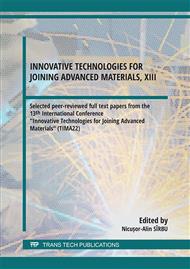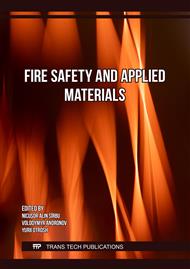[1]
X. Gao, C. Chen, X. Ren, Y. Li, Investigation on failure mechanism of the square clinched joints with different sheet thicknesses, Engineering Failure Analysis, Vol. 134, (2022) 106013
DOI: 10.1016/j.engfailanal.2021.106013
Google Scholar
[2]
A. Sahm, M. Gáspár, Á. Meilinger, Properties of hybrid aluminium-steel joints made by resistance spot welding, Defect and Diffusion Forum 416 pp.131-138 (2022)
DOI: 10.4028/p-3099yq
Google Scholar
[3]
M. Gáspár, H. Tervo, A. Kaijalainen, Á. Dobosy, I. Török, The Effect of Solution Annealing and Ageing During the RSW of 6082 Aluminium Alloy, K. Jármai and B. Bolló (Eds.): VAE 2018, Lecture Notes in Mechanical Engineering, p.694–708 (2018)
DOI: 10.1007/978-3-319-75677-6_59
Google Scholar
[4]
L. Ying, T. Gao, M. Dai, P. Hu, J. Dai, Towards joinability of thermal self-piercing riveting for AA7075-T6 aluminum alloy sheets under quasi-static loading conditions, International Journal of Mechanical Sciences, Vol. 189 (2021), 105978
DOI: 10.1016/j.ijmecsci.2020.105978
Google Scholar
[5]
G. Chen, K. Zeng, B. Xing, X. He, Multiple nonlinear regression prediction model for process parameters of Al alloy self-piercing riveting, Journal of Materials Research and Technology, Vol. 19 (2022) pp.1934-1943
DOI: 10.1016/j.jmrt.2022.05.118
Google Scholar
[6]
Y. Abe, T. Kato, K. Mori, S. Nishino, Mechanical clinching of ultra-high strength steel sheets and strength of joints, Journal of Materials Processing Technology, Vol. 214 (2014) pp.2112-2118
DOI: 10.1016/j.jmatprotec.2014.03.003
Google Scholar
[7]
T. Gerstmann, B. Awiszus, Recent developments in flat-clinching, Computational Materials Science, Vol. 81 (2014) pp.39-44
DOI: 10.1016/j.commatsci.2013.07.013
Google Scholar
[8]
Y. Liu, W. Zhuang, S. Wu, Damage to carbon fibre reinforced polymers (CFRP) in hole-clinched joints with aluminium alloy and CFRP, Composite Structures, Vol. 234 (2020) 111710
DOI: 10.1016/j.compstruct.2019.111710
Google Scholar
[9]
J. Varis, Economics of clinched joint compared to riveted joint and example of applying calculations to a volume product, Journal of Materials Processing Technology 172 (2006) 130–138
DOI: 10.1016/j.jmatprotec.2005.09.009
Google Scholar
[10]
X. He, Clinching for sheet materials, Science and Technology of Advanced Materials, 18:1, (2017) 381-405
Google Scholar
[11]
Y. Abe, K. Mori, T. Kato, Joining of high strength steel and aluminium alloy sheets by mechanical clinching with dies for control of metal flow, Journal of Materials Processing Technology 212 (2012) 884-889
DOI: 10.1016/j.jmatprotec.2011.11.015
Google Scholar
[12]
M. Carboni, S. Beretta, M. Monno, Fatigue behaviour of tensile-shear loaded clinched joints, Engineering Fracture Mechanics 73 (2006) 178-190
DOI: 10.1016/j.engfracmech.2005.04.004
Google Scholar
[13]
Ľ. Kaščák , E. Spišák, J. Majerníková, Joining three car body steel sheets by clinching method, Journal Open Engineering (2016) 6:566–573
DOI: 10.1515/eng-2016-0081
Google Scholar
[14]
C. Chen, H. Zhang, Y. Xu, J. Wu, Investigation of the flat-clinching process for joining three-layer sheets on thin-walled structures, Thin-Walled Structures, Vol. 157 (2020) 107034
DOI: 10.1016/j.tws.2020.107034
Google Scholar
[15]
S. Wiesenmayer, M. Merklein, Potential of shear-clinching technology for joining of three sheets, Journal of Advanced Joining Processes, Vol. 3 (2021) 100043
DOI: 10.1016/j.jajp.2021.100043
Google Scholar
[16]
J. Wang, Y. Wang, S. Wang, G. Lu, C. Zheng, Z. Ji, Experimental and numerical investigation on incremental laser shock clinching for joining three sheets of copper/aluminum/stainless steel, Optics & Laser Technology, Vol. 141 (2021) 107141
DOI: 10.1016/j.optlastec.2021.107141
Google Scholar
[17]
S. Saberi, N. Enzinger, R. Vallant, H. Cerjak, Influence of plastic anisotropy on the mechanical behavior of clinched joint of different coated thin sheets, International Journal of Material Forming (2018)
DOI: 10.1007/s12289-008-0349-9
Google Scholar



